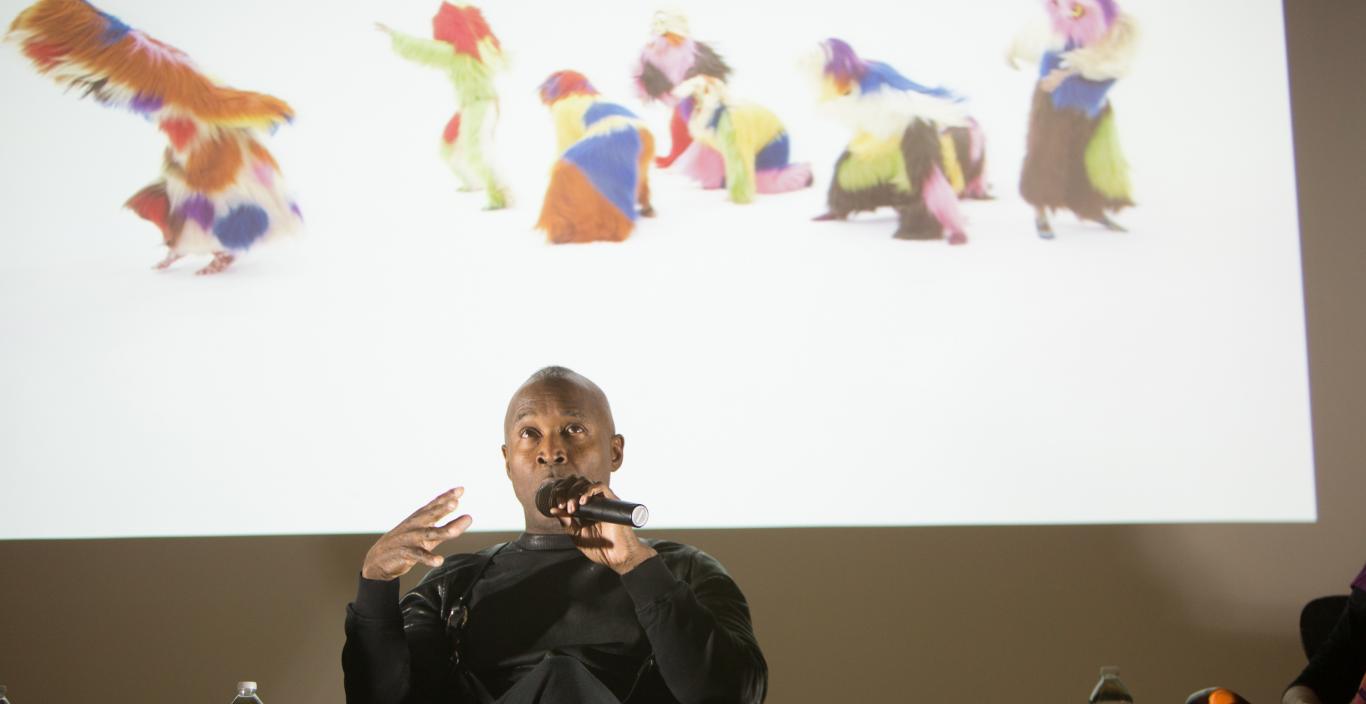“I’m a messenger first, not an artist,” Cave said, appearing March 2 as the latest speaker in the Strauch-Mosse Visiting Artist Lecture Series. Cave, a former Alvin Ailey dancer best known for his Soundsuits — full-body outfits that combine elements of sound, performance, color and costume — departed from the typical lecture format. Instead, he opted to show a 12-minute-long video of his performance art, which he calls “invasions.”
After that, he sat for a wide-ranging, free-form interview by College of Art and Design Dean Richard Zauft and Nancy Beardall, associate professor and program coordinator for dance/movement therapy.
Cave also took a few questions from the audience, on the condition that the questioner moved rhythmically to the microphone, eliciting laughter from the crowd.
“I look at dance as just another medium,” he told Beardall in response to the role dance has on his art. “I’m less interested in dance than movement.”
Later, he explained that, for him, the question is “How do we use our body as another instrument, another tool” in making art?
“It’s quite a challenge to categorize Nick’s work because of the highly interdisciplinary nature of it,” said Dean Emeritus Stan Trecker, in his introduction.
“In order to understand anything, we tend to want to put it in a category,” Cave said later. “I’m trying to defuse all that.”
In his introductory remarks, second-year student Rocky Cotard, one of Lesley’s Urban Scholars, admitted to some unexpected nerves, but then offered some definition of Cave. Highlighting the artist’s “wholly bizarre” hybrid creations, he pointed out Cave’s global reach and his “working between fabric sculpture, installation, performance, video, designed objects and fashion” and his exploration of the ways that “African identity is subsumed into disparate cultures.”
Cave seemed to approve of the introduction, saying, “Rocky, you rock! That was awesome.”
The work
Much discussion centered on Cave’s public installations and performance in New York’s Grand Central Terminal (“Heard NY,” 2013), a twice-daily performance with student dancers from the Ailey School dressed in his horse Soundsuits, grazing and interacting with passersby. Cave said he drew inspiration from the painting of a horse in the iconic train station, as well as the use of the rugged creatures during the terminal’s 19th-century construction.
As Cave told Paper magazine in 2013, he was also inspired by the human activity of the station.
“People are just moving through,” he told the magazine. “If there’s anything I can do to just sort of stop them for one second to change the momentum, or just alternate their day in an inspiring way, that’s really what this project is all about.”
In Cave’s mind, the art springs from the interaction, as well as the reaction to outside events. He built his first Soundsuit in 1992 in response to the Los Angeles riots that followed the brutal beating of black motorist Rodney King by police officers, who were subsequently acquitted by an all-white jury.
To Paper: “What I was interested in then was how they really just brought description to Rodney King’s identity and I was thinking, ‘What does that look like to me as a visual artist? What does it feel like to feel less than and discarded?’”
From that point, Cave realized he wanted to be an “artist with a conscience.”
In Washburn Auditorium, Cave responded to a question by Zauft: “Since that Rodney King piece, I recently finished TM 13, which is Trayvon Martin,” the black teenager shot and killed by a resident of the Florida neighborhood Martin was merely walking through. Cave added that, before the L.A. riots, he hadn’t quite realized that he is “an artist with a civic responsibility.”
“It’s my job to use art as a vehicle for change, to be an instigator,” he said, and then appeared to be holding back tears, thinking about it.
“I want to matter,” he said. “I’m only so emotional ‘cause it’s bigger than myself.”
The way forward
Cave clearly matters to the 300 or more audience members whose attentive silence was broken only by frequent laughter at the artist’s easy, extemporaneous commentary. Many asked him about his influences and inspiration for a given work of art.
“An object: that’s sort of the impulse,” Cave said. “The object becomes the instigator … I don’t draw anything.”
He explained that he and his collaborators will travel all over the country in search of objects that will eventually call the tune on what is created, even if it’s a kitsch dog figurine obtained locally, which is then made to recline on a gold settee purchased from a flea market in a different part of the country.
“My resources are really outside of my studio,” Cave said. “I will say, ‘Let’s get a one-way ticket to Washington state, and then we’ll get a cargo van … and that’s how I shop.”
And, he added, “After so many years of exercising, you kind of can get it. Don’t ever overthink it, ‘cause then you kill it.
“I just need new things to happen. I don’t know what I’m looking for, but when it’s there, there’s a pulse.”
Though Cave’s creative process might appear impulsive, it’s rooted in practicality and scrupulous work habits, he insisted.
“The starving artist concept? Not a reality,” he said. “Get a job so you can support your studio. You must keep working.”
For him, that meant dressing windows in New York department stores, arranging potluck dinners and studio sessions with his community of fellow artists. And creating.
“You just have to do things. You have to make things happen,” he said, though he added paradoxically, in response to another question, an artist has to know when not to do things, too.
“I might not go into the studio for four days and just hang out with my friends and do nothing,” Cave said. “It’s important to be quiet and just do nothing. How do we get quiet with ourselves? Because the answers are there.”
